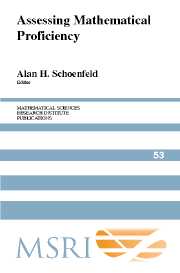Book contents
- Frontmatter
- Contents
- Preface
- Acknowledgments
- Section 1 The Big Picture
- 1 Issues and Tensions in the Assessment of Mathematical Proficiency
- 2 Aims of Mathematics Education
- 3 The No Child Left Behind Act: Political Context and National Goals
- Section 2 Perspectives on Mathematical Proficiency
- Section 3 What Does Assessment Assess? Issues and Examples
- Section 4 The Case of Algebra
- Section 5 What Do Assessments Assess? The Case of Fractions
- Section 6 The Importance of Societal Context
- Epilogue: What Do We Need to Know? Items for a Research Agenda
- About the Authors
- Subject Index
- Author Index
- Task Index
1 - Issues and Tensions in the Assessment of Mathematical Proficiency
Published online by Cambridge University Press: 06 July 2010
- Frontmatter
- Contents
- Preface
- Acknowledgments
- Section 1 The Big Picture
- 1 Issues and Tensions in the Assessment of Mathematical Proficiency
- 2 Aims of Mathematics Education
- 3 The No Child Left Behind Act: Political Context and National Goals
- Section 2 Perspectives on Mathematical Proficiency
- Section 3 What Does Assessment Assess? Issues and Examples
- Section 4 The Case of Algebra
- Section 5 What Do Assessments Assess? The Case of Fractions
- Section 6 The Importance of Societal Context
- Epilogue: What Do We Need to Know? Items for a Research Agenda
- About the Authors
- Subject Index
- Author Index
- Task Index
Summary
Introduction
You'd think mathematics assessment—thought of as “testing” by most people—would be simple. If you want to know what a student knows, why not write (or get an expert to write) some questions about the content you want examined, give those questions to students, see if the answers are right or wrong, and add up a total score? Depending on your predilections (and how much time you have available) you might give a multiple-choice test. You might give an “open answer” or “constructed response” test in which students show their work. You could give partial credit if you wish.
This version of assessment fits with most people's experiences in school, and fits with descriptions of the National Assessment of Educational Progress (NAEP) as “the nation's report card.” From this perspective, mathematics assessment—discovering what mathematics a person (typically, a student) knows—seems straightforward.
Would that things were so simple. As this essay and later contributions to this volume will indicate, different groups can have very different views of what “counts,” or should count, in mathematics. Assessing some aspects of mathematical thinking can be very difficult—especially if there are constraints of time or money involved, or if the tests have to have certain “psychometric” properties (discussed further in this essay) in order to make sure that the test-makers stand on legally safe ground. Different groups may want different information from tests.
- Type
- Chapter
- Information
- Assessing Mathematical Proficiency , pp. 3 - 16Publisher: Cambridge University PressPrint publication year: 2007
- 1
- Cited by



